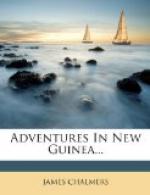Because of a strong head wind, we could not leave the next day, so Mr. McFarlane and I returned to the shore. We found the children collected in Gucheng’s house, learning to write the letters on slates. There were very few girls present—indeed, there are not many girls on the island, so many have been destroyed by their fathers at birth. We strolled about and visited the large cocoanut plantation belonging to the society. On our return we found the teacher and a number of natives collected near the beach. They had just buried a man who had died the night before—so Christian burial has begun. Formerly, the body would have been hung up and tapped, to allow the juices to run out, which would have been drunk by the friends. We returned to the mission house for dinner. I was glad to find so many boys living with Gucheng. They were bright, happy little fellows, romping about, enjoying themselves.
We did not get away from Darnley Island till the morning of Wednesday, the 10th. The navigation between Darnley and Murray Islands is difficult, arising from various reefs and currents. Although only twenty-seven miles separate the two, it was Friday night before we anchored at Murray Island. We went ashore the same night.
On Saturday, we climbed to the highest point of the island, seven hundred feet high. There seems to be no lack of food, chiefly grown inland. From the long drought, the island presented in many places a parched look, and lacked that luxuriance of vegetation to which we had been so long accustomed on Rarotonga.
At the forenoon meeting on Sunday there were nearly two hundred present. Mr. McFarlane preached. A few had a little clothing on them; some seemed attentive, but the most seemed to consider the occasion a fit time for relating the week’s news, or of commenting on the strangers present. The Sabbath is observed by church attendance and a cessation from work. There is not much thieving on the island; they are an indolent people. The school is well attended by old and young, and Josiah, the teacher, has quite a number of children living with him. They sing very well.
Several of the old men here wear wigs. It seems when grey hairs appear they are carefully pulled out; as time moves on they increase so fast that they would require to shave the head often, so, to cover their shame, they take to wigs, which represent them as having long, flowing, curly hair, as in youth. Wigs would not astonish the Murray islanders, as Mr. Nott’s did the Tahitians after his return from England. They soon spread the news round the island that their missionary had had his head newly thatched, and looked a young man again.




